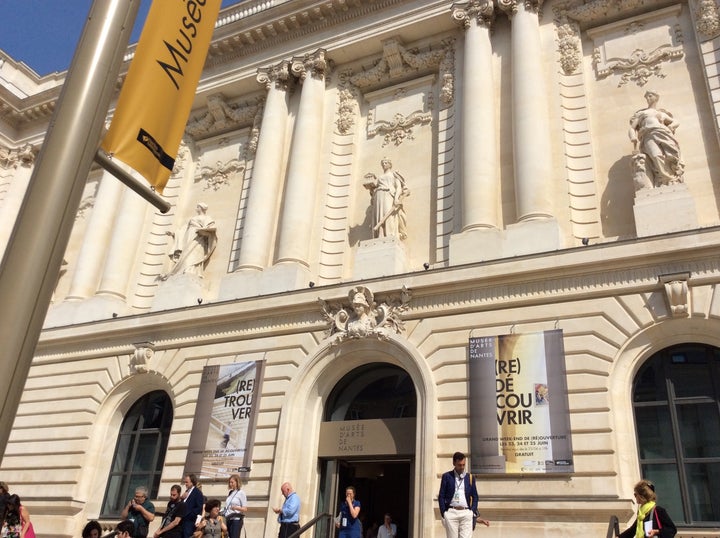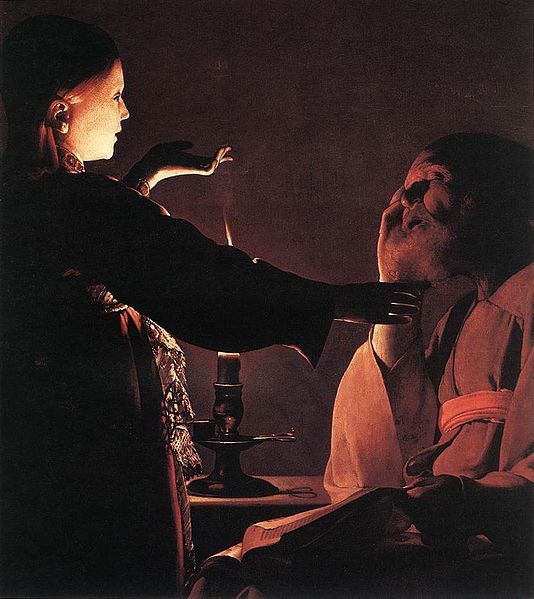
Earlier this summer, just in time to celebrate the national birthdays of both America and France, a new museum opened in Nantes, that cultural jewel of western France. The museum had been around for more than a century, then closed itself six years ago for a wholesale remake. Previously known as Le Musée des Beaux Arts (the Museum of Fine Arts), it now calls itself simply the Museum of Art. Not modern. Not contemporary. Not classical. Just art.
From the outside, it looks like a scrubbed-up Greek temple. Step inside—as 15,000 people did on the first weekend of July—and you will immediately know that this is indeed a temple, the sort of secular temple that is steadily replacing historic cathedrals and other religious monuments across the Western world. A marvel of raining glass filaments cascades down from the central sunlit atrium. Then, as you wander through the bright storm and traverse two floors past history-eating paintings and sculptures, devour any notion of orderly time: chronology fades into a floating mirage of misperception represented by renaissance roses that decorate contemporary comedians.
But before descending too deeply into the maelstrom of tormented time, it is well to dwell a while on what we mean when we call a building a museum. The word itself comes from the Greeks, who saw their stone-columned pediments as nothing less than the hearth places of the gods—or muses—who were responsible for planting the seeds of inspiration in mortals. To enter into those sacred marble zones was to enter into the possibility of transcendence.

Museums as we understand them are relatively new creations. They were first imagined as cabinets of curiosities, rooms stocked with odd and beautiful objects collected by kings, queens, princes and early Renaissance entrepreneurs. They were not intended to educate or amuse the children of ordinary peasants and accountants but rather to remind and reassure the children of the nobility of their own importance in the march of human culture. These precious acquisitions [ss3] were housed in what the French call châteaux and the Italians palazzi. Steadily, the laws of scarcity and the passions of historical excavators turned these private collections into ever-greater monuments whose mission was not merely to fulfill private curiosity, but to celebrate national power and grandeur, as family tribalism ceded its place to imperial self-confidence and dominance.
International museologist[ss4] Vanda Vitalli describes this institutional shift in its most practical light: “Museums were always designed to be temples. The American Museum of National History in New York, the Philadelphia Museum of Art, the MET, the British Museum—they all look like grand temples. Here in Paris, the Louvre marks France as a nation not merely as Aquitaine or Burgundy but France in its collective power and presence. Most of the great museums were first created at the time the nation-state itself was being born.”
American art journalist Jason Farago, who writes for the New York Times and the Guardian, argues that museums nowadays, like the restored Museum of Art in Nantes, have become secular cathedrals intended to instill awe, reflection, and meditation: “If churches and cathedrals once stood at the top of the architectural hierarchy, today the museum is the building form that every serious architect dreams of designing. The financial Medicis of the 21st century are not throwing much money at religious institutions—but a new museum, especially one offering naming rights, can attract the sort of budget that would once have been reserved for a cathedral. As a question of architectural ambition, art museums are the new churches: that much should be clear by now. But who are these new churches’ parishioners, and what sort of worship is going on?”
Unlike the desperate evangelical flocks that worship people like the serial liar Donald Trump or the isolationist Marine Le Pen, the parishioners of these art and science temples are not much interested in the old deities. Where earlier museums were largely intended to inform small-town residents of a powerful world beyond their experience, today’s museum visitors are a global salad of the curious, or so believes Sophie Lévy, the director of Nantes’ Museum of Art. “Nowadays, she says, “cities and countries are far from withdrawn and the audience is increasingly nomadic. The new name [of the Nantes museum] breaks from this universal, and eminently hierarchic, legacy to an extent. More democratic, less formal, and widely open to contemporary art.”
Mixing 16th century and 21st century pieces in the same room, she insists, does not erase historic legacies. It links today with the past and shows just how the past remains present in even the most contemporary images. “Museums are anachronistic. You are here today and you look into the past, but not as though those things were always there. You’re like a burier. Excavating. And you’re trying to bring back to yourself those things and bringing it to your own time. I’ve always thought this is a crucial element about art.”
Lévy speaks of Georges de La Tour’s iconic The Dream of St. Joseph, in which an aged Joseph, eyes shut, seems to look at an innocent-faced young woman. “It’s incredible. It was done nearly 400 years ago. When I look at it, the miracle looks as though it’s just taking place in front of me. I’m unable to explain why. It has something to do with the big empty space at the center of the scene. The actual subject of the painting is not the characters or what the story is telling, but at the center of the piece is the big, empty void. And it’s lit only by this hidden candle.”

She paused. “If the painting is only a testimony of the past, it doesn’t work. Something doesn’t work. It has to come back to you. You have to be able to pull it to yourself. Writing history is exactly the same. You shouldn’t try to discover how things were, because that’s just impossible. You have to find how history is still relevant. Or could save you now. For me museums are about this question.
“So actually putting a contemporary work next to an old master’s work, if they are connected in some way, opens up each one.” A large collection of the radical anarchist 1960s painter Jean-Jacques Lebel and of 16th- and 17th-century masters documenting the social life of their time seems to create a cross dialogue among people, time, and place. “It’s interesting to see that the way [Lebel] envisioned art is related to the way other artists in that gallery envisioned their own work. To me it’s not an intellectualism of a curator; on the contrary, when I saw visitors reacting, they didn’t see it as intellectual at all. They thought it was fun. They thought it was challenging—and in a way that woke them up from this kind of usual [path] of going through museums century by century . . . and getting bored.”
Unlike many stodgier elite museums, Nantes under Lévy aims not so much to instruct its visitors as to provoke them in all its diversity.
“When you organize the installation of a room, you’re trying to find a moment of perfect balance for yourself, which is a relationship between your own body, the space and the works. That balance is not only intellectual. It’s a question of the proportions, the forms, the height of the space, the light. You are your own visitor, your own first visitor in an installation. . . . When I did my first exhibition, it was a contemporary art exhibition [with] a living artist. And he said, ‘Each wall is waiting for its work.’ I felt that was a little strange, but I think now I understand what he meant. It’s kind of . . . you trying to find the installation that will give the impression that it needed to be that way and not something else. So I’m not sure what it has to do with memory or with time. I have a stronger feeling about space.
Which gets us back to temples. At their worst, temples demand deference to untouchable authority, but at their best, they invite us to reflect on what it means to be alive in time and space, to meditate on our brief sojourn in time and place and to project our eyes into the space of time. Many churches and religious sites may still serve that function, but the hell, fire and brimstone of hate and resentment trumpeted by the fundamentalist demagogues and their elected megaphones seem to have captured most of today’s spiritual oxygen, turning aid, not reflection into their primary anthem. Their sermons are as simple as their pop-up architecture is brutal. By contrast transcendence and inner contemplation more and more seems to be moving to these new contemporary aesthetic temples that have captured the wit and inspiration of the world’s finest architects. Maybe they will save us from the brimstone and fluffed up ash of evangelical resentment.
